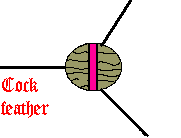

Tools and materials needed,
Saw, tape measure, sandpaper, tapering tool, fletching tool, epoxy based glue,model cement,lacquer.

Introduction
An arrow basically consists of four parts: the pile (arrow point) the shaft, the nock and the fletches or feathers.

Making your arrows
A large number of woods are suitable to produce a shaft. However, you cannot use just any old stick,the shaft must be absolutely straight. Also, an arrow must have a certain stiffness, so that it will not bend too much when loosed from a heavy bow, or remain too inflexible when loosed from a light bow.The stiffness or "spine" of your arrow must correspond to the strength of your bow. The easiest thing is to contact your Archery shop and buy them already selected for your needs. Be sure to tell the strength of the bow to the salesperson so that you will get the proper set of shafts. If you are shooting a 40 lbs bow select shafts that have been weighed for 40 - 45 lbs.

You will also need the piles (points), nocks and fletches (feathers). All items are available from your Archery dealer.
For a 40 lbs longbow select shafts with a diameter of 5/16"

The piles or points come in many varieties. For target shooting I prefer the brass ones, tapered inside, because they are easier to fit with the aid of a tapering tool. The tapering tool is a kind of double barrelled "pencil sharpener", one half produces the tapering needed to fit the pile to the shaft, the other tapers the back of the shaft so that it will accommodate the nock.

Next establish your draw length. Ideally only the pile may protrude from the bow when fully drawn. One way of doing this is by placing one end of the shaft on your breastbone and then reaching forward with both arms until the tips of your fingers come together on the shaft And add 1/2". It is better to have your draw length established in your Archery shop. The salespeople can measure your draw lenght more acuratly.

Next use the tapering tool to taper the front of the shafts to accommodate the piles. Glue the piles to the shafts using epoxy based glue after scouring the inside with a degreaser. Allow them to dry.

Shorten the shaft to your draw length allowing an extra 1inch for the length of the pile and 1inch for the length of the nock. (So your draw length plus 2").

Important!
Before you start
tapering the end which will accommodate the nock, first establish
how the grain of the shaft runs, The nock will have to be fitted
so that the string is positioned at a right angle to the grain.
Mark with a pencil the position of the cock feather, i.e. the
fletch  or feather that is
positioned at a right angle to the string Then taper the back of the shaft using
the tapering tool.
Glue the nocks in position and allow to dry. Here again it is a
good idea to use epoxy based glue as the nock will have to
withstand a lot of punishment as does the pile.
or feather that is
positioned at a right angle to the string Then taper the back of the shaft using
the tapering tool.
Glue the nocks in position and allow to dry. Here again it is a
good idea to use epoxy based glue as the nock will have to
withstand a lot of punishment as does the pile.

Fletching
To apply the fletches, and, mind you, for traditional shooting you need actual birds' feathers, you will need a fletching tool. (the fletches have to be applied at exactly 120o angles.)

This process may take a while, depending on how fast the glue you use sets.Almost any glue will do. There is a special type of glue for fletching but,model cement works just as well. As long as it fixes the feathers to the wooden shaft it is all right.

Apply the fletches 1/2 " from the nock. Insert the fletch into the tool, sand the back of the fletch, apply the glue and fix it on the shaft. Repeat the process with the other two and repeat the process for each arrow you make.

The arrows can now be finished by applying two layers of lacquer to the entire shaft. In order to avoid "feather cuts", rather nasty cuts in your bow hand caused by the sharp end of the fletch, it is a good idea to apply a small drop of glue to the feather that may cause the damage.
